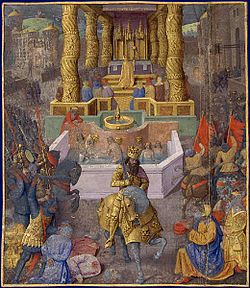Herodian kingdom
Herodian kingdom | |||||||||
|---|---|---|---|---|---|---|---|---|---|
| 37 BC–4 BC | |||||||||
Hebrew | |||||||||
| Religion | Second Temple Judaism Samaritanism Roman imperial cult | ||||||||
| Government | Monarchy | ||||||||
| King | |||||||||
• 37 BC – 4 BC | Herod the Great | ||||||||
| Historical era | Tetrarchy | 4 BC | |||||||
| Currency | Herodian coinage | ||||||||
| |||||||||
| Today part of | |||||||||
| History of Israel | |
|---|---|
 | |
| 538–333 BCE | |
| Hellenistic period | 333–164 BCE |
| Hasmonean dynasty | 164–37 BCE |
| Herodian dynasty | 37 BCE–6 CE |
| Roman Judaea
Jewish-Roman Wars ) | 6 CE–136 CE |
The Herodian kingdom
The Herodian kingdom included the regions of
Background
Roman involvement in the Levant
The first intervention of Rome in the region dates from 63 BCE, following the end of the
When
Parthian invasion and Roman intervention
After Julius Caesar was murdered in 44 BCE,
"Antigonus... roused the Parthians to invade Syria and Palestine, [and] the Jews eagerly rose in support of the scion of the Maccabean house, and drove out the hated Idumeans with their puppet Jewish king. The struggle between the people and the Romans had begun in earnest, and though Antigonus, when placed on the throne by the Parthians, proceeded to spoil and harry the Jews, rejoicing at the restoration of the Hasmonean line, thought a new era of independence had come.[6]
When Phasael and Hyrcanus II
Antigonus, whose Hebrew name was Mattathias, bore the double title of king and High Priest for only three years. He had not disposed of Herod, who fled into exile and sought the support of Mark Antony. Herod was designated "King of the Jews" by the Roman Senate in 40 BCE: Antony "then resolved to get [Herod] made king of the Jews...[and] told [the Senate] that it was for their advantage in the Parthian war that Herod should be king; so they all gave their votes for it. And when the senate was separated, Antony and Caesar [Augustus] went out, with Herod between them; while the consul and the rest of the magistrates went before them, in order to offer sacrifices [to the Roman gods], and to lay the decree in the Capitol. Antony also made a feast for Herod on the first day of his reign."[7]
The struggle thereafter lasted for some years, as the main Roman forces were occupied with defeating the Parthians and had few additional resources to use to support Herod. After the Parthian defeat, Herod was victorious over his rival in 37 BCE. Antigonus was delivered to Antony and executed shortly thereafter, bringing about the end of the Hasmonean rule over Israel.
Herod as king

King Herod has become known among the archaeologists as Herod the Builder, and under his reign Judea experienced an unprecedented construction, still obtaining an impact on the landscape of the region. Under his enterprise, such projects as the Masada fortress, the Herodion and the great port of Caesarea Maritima were built.
Fate of the Hasmonean dynasty under Herod
Antigonus was not, however, the last male Hasmonean;
During King Herod's reign, the last male representatives of the
The later Herodian rulers
Dissolution: formation of the Tetrarchies
Herod died in 4 BCE, and his kingdom was divided among his three sons, none of them inherited his title of king (
See also
- Coele-Syria
- Herodian dynasty
- List of biblical figures identified in extra-biblical sources
- Temple in Jerusalem
References
- ^ History of the Christian tradition (Vol. 1), Thomas D. McGonigle; James F. Quigley, Paulist Press, 1988 p. 39
- ISBN 978-1-4982-2454-3.
- magistrateswent before them, in order to offer sacrifices [to the Roman gods], and to lay the decree in the Capitol. Antony also made a feast for Herod on the first day of his reign."
- ISBN 978-0-674-77886-3.
- ^ Antiquities of the Jews 14.5.4 Archived 2008-03-27 at the Wayback Machine: "And when he had ordained five councils (συνέδρια), he distributed the nation into the same number of parts. So these councils governed the people; the first was at Jerusalem, the second at Gadara, the third at Amathus, the fourth at Jericho, and the fifth at Sepphoris in Galilee." Jewish Encyclopedia: Sanhedrin Archived 2011-09-27 at the Wayback Machine: "Josephus uses συνέδριον for the first time in connection with the decree of the Roman governor of Syria, Gabinius (57 BCE), who abolished the constitution and the then existing form of government of Palestine and divided the country into five provinces, at the head of each of which a sanhedrin was placed ("Ant." xiv. 5, § 4)."
- ^ Bentwich, Chapter I.
- ^ "Josephus, Wars Book I". earlyjewishwritings.com. Archived from the original on 2019-10-26. Retrieved 2011-09-19.
